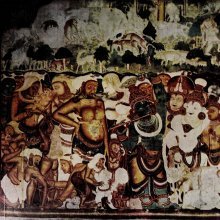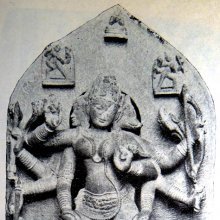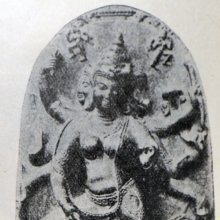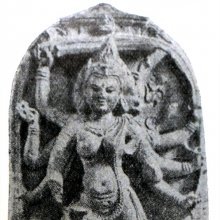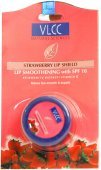Lip: 11 definitions
Introduction:
Lip means something in Hinduism, Sanskrit. If you want to know the exact meaning, history, etymology or English translation of this term then check out the descriptions on this page. Add your comment or reference to a book if you want to contribute to this summary article.
Images (photo gallery)
In Hinduism
Gitashastra (science of music)
Source: Shodhganga: Elements of Art and Architecture in the Trtiyakhanda of the Visnudharmottarapurana (gita)The Lips (in Sanskrit: Oṣṭha) refers to one of various Organs of Utterance (sthāna), according to Bhattojidīkṣita in his Siddhāntakaumudī.—During the practise of Vocal Music, the proper production of the concerned sound is always considered as very important. Sthāna or ucchāraṇasthāna is the place of articulation of sound. Bhattojidīkṣita in his Siddhāntakaumudī said about ten kinds of sthāna (i.e., the organs of utterance), e.g., oṣṭha (lips).
Gitashastra (गीतशास्त्र, gītaśāstra) refers to the ancient Indian science of Music (gita or samgita), which is traditionally divided in Vocal music, Instrumental music and Dance (under the jurisdiction of music). The different elements and technical terms are explained in a wide range of (often Sanskrit) literature.
Shilpashastra (iconography)
Source: Shodhganga: Elements of Art and Architecture in the Trtiyakhanda of the Visnudharmottarapurana (shilpa)The Lips are denoted by the Sanskrit term Oṣṭha, and represents one of the various body parts whose Measurements should follow the principles of ancient Indian Painting (citra), according to the Viṣṇudharmottarapurāṇa, an ancient Sanskrit text which (being encyclopedic in nature) deals with a variety of cultural topics such as arts, architecture, music, grammar and astronomy.—In the third part of the Viṣṇudharmottarapurāṇa, chapters 35th to 43rd are dedicated to the Painting of different portraits of different kinds of men and women. The measurement of almost all the body parts that should be maintained in a picture have been presented here. For example, the Lips (oṣṭha) should be 12 aṅgulas.

Shilpashastra (शिल्पशास्त्र, śilpaśāstra) represents the ancient Indian science (shastra) of creative arts (shilpa) such as sculpture, iconography and painting. Closely related to Vastushastra (architecture), they often share the same literature.
Languages of India and abroad
Sanskrit dictionary
Source: DDSA: The practical Sanskrit-English dictionaryLip (लिप्).—6 U. (limpati-te, lipta)
1) To anoint, smear, besmear; लिम्पतीव तमोऽङ्गानि (limpatīva tamo'ṅgāni) Mṛcchakaṭika 1.34.
2) To cover, overspread; plaster; लिप्तेषु भासा गृहदेहलीनाम् (lipteṣu bhāsā gṛhadehalīnām) Śiśupālavadha 3.48.
3) To stain, pollute, defile, taint, contaminate; यः करोति स लिप्यते (yaḥ karoti sa lipyate) Pañcatantra (Bombay) 4.64; न मां कर्माणि लिम्पन्ति (na māṃ karmāṇi limpanti) Bhagavadgītā (Bombay) 4.14;18.17; Manusmṛti 1.16.
4) To inflame, kindle; तस्यालिपत शोकाग्निः स्वान्तं काष्ठमिव ज्वलन् (tasyālipata śokāgniḥ svāntaṃ kāṣṭhamiva jvalan) Bhaṭṭikāvya 6.22. -Caus.
1) To cast blame on anyone.
2) To smear anything.
Source: Cologne Digital Sanskrit Dictionaries: Shabda-Sagara Sanskrit-English DictionaryLip (लिप्).—[(ñi, au) ñi aulipa] r. 6th cl. (limpati-te) 1. To increase or add to. 2. To anoint, to smear, to plaster. 3. To cover. 4. To kindle, to inflame. 5. To stain, to pollute. With anu, 1. To besmear, to anoint. 2. To cover, to envelop. With ava, To anoint. With ā, 1. To besmear. 2. To contaminate. With vi, To besmear.
Source: Cologne Digital Sanskrit Dictionaries: Benfey Sanskrit-English DictionaryLip (लिप्).—i. 6, limpa, [Parasmaipada.] [Ātmanepada.] 1. To anoint, [Bhaṭṭikāvya, (ed. Calc.)] 14, 94. 2. To smear, [Hitopadeśa] 21, 14. 3. To stain (lipyate doṣeṇa, Incurs sin), [Hitopadeśa] ii. [distich] 118; to pollute, [Mānavadharmaśāstra] 4, 201; 10, 104. 4. To burn, [Bhaṭṭikāvya, (ed. Calc.)] 6, 22. Ptcple. of the pf. pass. lipta. 1. Envenomed. 2. Embraced. 3. Defiled. Comp. A-medhya -lipta, adj. defiled (soiled with impurity), [Mānavadharmaśāstra] 4, 56. [Causal.] To cause to be decorated, [Rāmāyaṇa] 2, 9, 40.
— With the prep. anu anu, 1. To anoint, [Daśakumāracarita] in
— With ava ava, To smear, [Lassen, Anthologia Sanskritica.] 9, 19. avalipta, Proud, arrogant, [Mānavadharmaśāstra] 4, 79; [Pañcatantra] i. [distich] 341.
— With ā ā, 1. To anoint, [Uttara Rāmacarita, 2. ed. Calc., 1862.] 79, 1; [Ṛtusaṃhāra] 6, 12, v. r. 2. To smear, [Pañcatantra] 171, 11.
— With samā sam-ā, To anoint, [Bhaṭṭikāvya, (ed. Calc.)] 17, 5.
— With upa upa, To pollute, Mahābhārata 2, 2625; [Bhagavadgītā, (ed. Schlegel.)] 13, 32. [Causal.] To let smear, [Mānavadharmaśāstra] 3, 206.
— With vi vi, 1. To anoint, [Bhaṭṭikāvya, (ed. Calc.)] 3, 20. 2. To smear, [Lassen, Anthologia Sanskritica.] 9, 12. 3. To pollute, [Hitopadeśa] 128, 12.
— With sam sam, To anoint, Mahābhārata 1, 4950.
— Cf. - [Latin] limpidus, lippus; probably also liquidus, liquere, and [Old High German.] salba, [Gothic.] salbôn, [Anglo-Saxon.] sealf.
Source: Cologne Digital Sanskrit Dictionaries: Cappeller Sanskrit-English DictionaryLip (लिप्).—limpati limpate [participle] lipta (q.v.) smear, stain, soil (lit. & [figuratively]), besmear with ([instrumental]) or smear a th. ([accusative]) over or on a th., stick on to ([locative]); [Passive] lipyate cleave or stick to ([intransitive]). [Causative] lepayati & limpayati = [Simple] tr.
Source: Cologne Digital Sanskrit Dictionaries: Monier-Williams Sanskrit-English Dictionary1) Lip (लिप्):—(cf √rip) [class] 6. 1.[Ātmanepada] [Parasmaipada] ([Dhātupāṭha xxviii, 139]) limpati, te ([perfect tense] lilepa, [Brāhmaṇa] etc.; [Aorist] alipat, [Kathāsaritsāgara]; alispata, alipta [grammar]; -alipsata, [Ṛg-veda]; [future] leptā, lepsyati, te [grammar]; [infinitive mood] leptum, [ib.]; [indeclinable participle] -lipya, [Brāhmaṇa] etc.),
—to smear, besmear, anoint with ([instrumental case]), stain, soil, taint, pollute, defile, [Taittirīya-brāhmaṇa] etc. etc.;
—to inflame, kindle, burn, [Bhaṭṭi-kāvya] :—[Passive voice] lipyate ([Epic] also ti; [Aorist] alepi),
—to be smeared etc.;
—to be attached to ([locative case]), stick, adhere, [ĪśUp.] :;—[Causal] lepayati ([Aorist] alīlipat), to cause to smear etc.;
—to smear or anoint anything ([accusative]) with ([instrumental case]) or on ([locative case]), [Hemādri’s Caturvarga-cintāmaṇi; Suśruta];
—to cover, [Rāmāyaṇa];
—to cast blame on any one, [Sāyaṇa];
— (limpayati), to smear anything ([accusative]) with ([instrumental case]) :—[Desiderative] lilipsati, te [grammar]:—[Intensive] leliyate, lelepti[ib.]
2) cf. [Greek] ἀ-λείφω, λιπαρός, [Latin] lippus; [Lithuanian] lípti; [Gothic] bileiban; [German] bilíian, blīben, bleiben, leben, Leib; [Anglo-Saxon] libban; [English] live, life.
Source: Cologne Digital Sanskrit Dictionaries: Yates Sanskrit-English DictionaryLip (लिप्):—(śa, ña, au, pa, ña) limpati, te 6. c. To increase or add to; to anoint, smear, plaster.
Source: DDSA: Paia-sadda-mahannavo; a comprehensive Prakrit Hindi dictionary (S)Lip (लिप्) in the Sanskrit language is related to the Prakrit words: Kharaḍa, Lia, Liṃpa.
[Sanskrit to German]
Sanskrit, also spelled संस्कृतम् (saṃskṛtam), is an ancient language of India commonly seen as the grandmother of the Indo-European language family (even English!). Closely allied with Prakrit and Pali, Sanskrit is more exhaustive in both grammar and terms and has the most extensive collection of literature in the world, greatly surpassing its sister-languages Greek and Latin.
See also (Relevant definitions)
Starts with (+115): Lip anian, Lipa, Lipa-que-pojua, Lipaghasa, Lipai, Lipana, Lipandava, Lipanem, Lipang aso, Lipang kalabaw, Lipang-dutong, Lipang-kalabau, Lipangala, Lipapota, Lipaputa, Lipata, Lipatana, Lipate, Lipatna, Lipauen.
Ends with (+21): Abhiklip, Abhilip, Alip, American cowslip, Anuklip, Anulip, Avaklip, Avalip, Cowslip, Klip, Kshuraklip, Lapalip, Lower lip, Nilip, Ouklip, Pariklip, Parilip, Paryupalip, Praklip, Pralip.
Full-text (+942): Oshtha, Adhara, Adharoshtha, Uttaradhara, Liccha, Adharamrita, Bimbadhara, Otha, Bimboshtha, Kharada, Dantacchada, Oshthapallava, Adharapana, Lia, Ravakhandem, Oshthya, Lipi, Dasanacchada, Laba, Radacchada.
Relevant text
Search found 264 books and stories containing Lip; (plurals include: Lips). You can also click to the full overview containing English textual excerpts. Below are direct links for the most relevant articles:
Brihat Samhita (by N. Chidambaram Iyer)
Chapter 66 - On the features of the Horse (aśva-lakṣaṇa)
Chapter 70 - On the features of women (kanyā-lakṣaṇa)
Chapter 105 - On the worship of the stellar deity (rūpasatra)
Cosmetics, Costumes and Ornaments in Ancient India (by Remadevi. O.)
2.6. Pharmaceutical use of Lipstick < [Chapter 1 - Cosmetics]
3.6. Ornamental Painting < [Chapter 1 - Cosmetics]
7. Cosmetics According to Different Regions < [Chapter 1 - Cosmetics]
Garga Samhita (English) (by Danavir Goswami)
Verse 5.14.11 < [Chapter 14 - The Meeting of King Nanda and Uddhava]
Verse 5.12.22 < [Chapter 12 - Pancajana’s Previous Birth]
Verse 1.13.16 < [Chapter 13 - The Liberation of Pūtanā]
Bhakti-rasamrta-sindhu (by Śrīla Rūpa Gosvāmī)
Verse 4.5.23 < [Part 5 - Anger (raudra-rasa)]
Verse 1.2.239 < [Part 2 - Devotional Service in Practice (sādhana-bhakti)]
Verse 2.3.93 < [Part 3 - Involuntary Ecstatic Expressions (sattvika-bhāva)]
Sahitya-kaumudi by Baladeva Vidyabhushana (by Gaurapada Dāsa)
Text 4.14 < [Chapter 4 - First-rate Poetry]
Text 10.253 < [Chapter 10 - Ornaments of Meaning]
Text 2.33 < [Chapter 2 - The Natures of Words (śabda)]
Naishadha-charita of Shriharsha (by Krishna Kanta Handiqui)
Related products
(+22 more products available)
